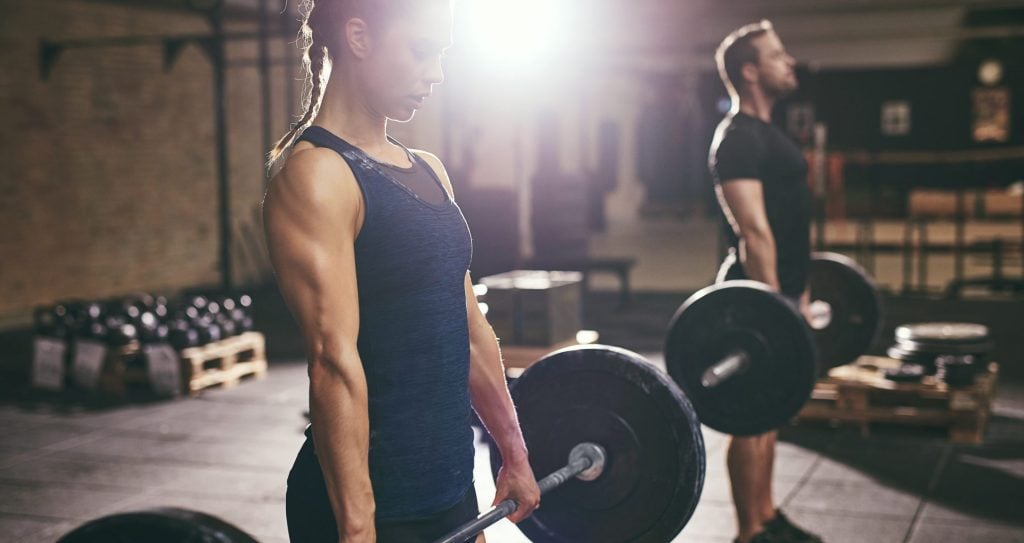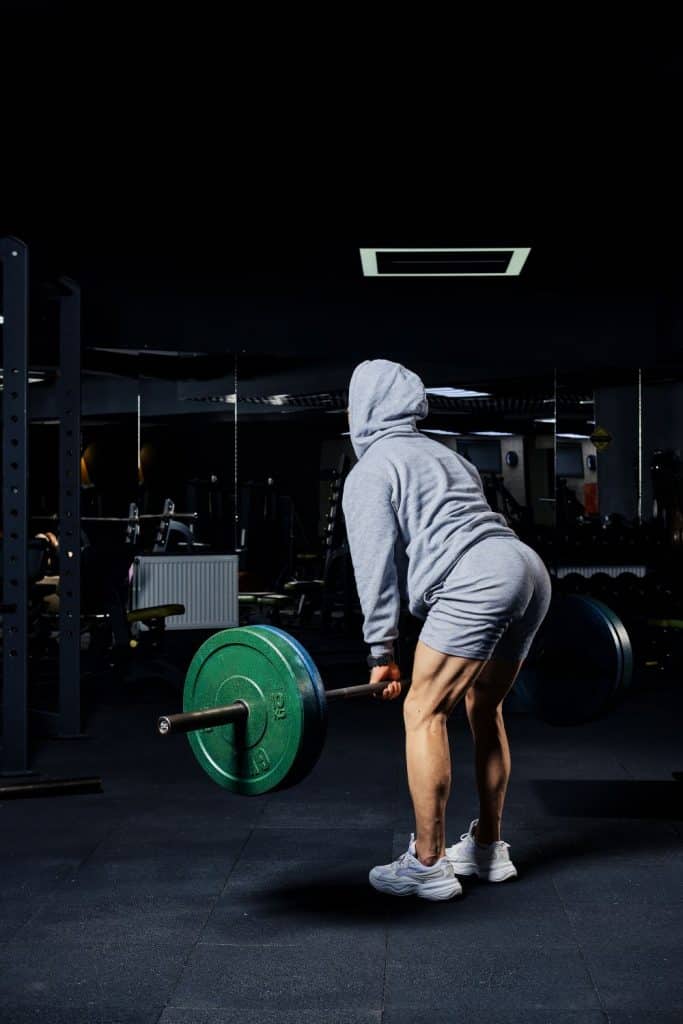Learn the stiff leg deadlifts for increased athletic ability and explosive lower body strength.
Developing a strong posterior chain–hamstrings and back muscles–are imperative to build a robust and athletic physique that not only looks good, but also functions well. Your posterior chain is responsible for hip flexion and extension, which is the foundation of explosive movements such as sprinting and jumping. Hip flexion and extension also play a crucial role in squats and deadlifts. Therefore, increasing your hip flexion and extension strength will increase your strength on two of the most important lifts for a strong physique (squats and deadlifts). The stiff leg deadlifts are one of the best movements you can do to strengthen your posterior chain and develop powerful hip flexion and extension (1).
Of course, it’s essential that you use the proper form to fully target the desired muscles and prevent injury. And any movement that hits your lower back (stiff leg deadlifts do), it’s even more important to nail your form to keep your back healthy. To build a solid athletic physique, continue reading to learn how to do them.
Stiff Leg Deadlifts Technique and Muscles Worked
The stiff-leg deadlifts are similar to conventional deadlifts, except, as the name suggests, with straight legs. Keeping your knees from bending during a deadlift will engage more of your hamstrings and challenge your hip flexors and extensors more (2).
The following steps will help you master them to strengthen your hip flexors, extensors, and hamstrings.
Starting Position
The first step in performing this exercise is to get into your starting position. Grab a barbell with a shoulder-width grip and stance, using a conventional deadlift form to pull the barbell from the ground and let it hang below your hips. This is your starting position.
Hip Flexion
Next, you’ll flex your hips while keeping a slight static bend in your knees (to protect your knee joints) and lower the barbell past your knees until your back is parallel with the ground and you feel your hamstrings stretch. Keeping the barbell as close to your body as possible will allow you to lift more weight and protect your lower back.
Hip Extension
You’ll then extend your hips to pull the weight back to the starting position. Keeping your back straight and legs straight through the full range of motion is essential to engage your muscles properly and prevent back injury.
Benefits of Stiff Leg Deadlifts
This movement strengthens your lower body, improves athletic performance, and prevents leg injuries.
Stronger Lower Body
Since this exercise target the muscles in your posterior chain, it will increase your strength in movements that require your back and hamstrings, such as deadlifts and squats.
Furthermore, the stiff leg deadlifts strengthen your hip extensors and flexor muscles, and flexion and extension are vital for deadlifts and squats. And since the deadlifts and squats are considered “the king of all exercises,” improving your strength on stiff leg deadlifts will make you stronger overall.
Improve Athletic Performance
Of course, a more muscular lower body will increase your athletic performance since strengthening your squats and deadlifts can make you faster and improve your jumping ability. And jumping and spriting play a crucial role in many sports. Furthermore, your hip flexor, extensor muscles, and glutes are essential for sprinting and jumping (3).
Prevent Injury
Often, it’s easier to pull your hamstrings than your quads. That’s because many people spend hours a day sitting, which overactive your quad muscles and under-activates your glutes and hamstrings. In addition, your hamstrings only contain three muscles, while your quads are composed of four muscles. And since your quads and hamstrings are antagonistic pairs–as one muscle contracts, the other lengthens–you’re more likely to injure your hamstrings with a weak posterior chain.
Stiff Leg Deadlifts Alternatives
Although the barbell stiff leg deadlifts are the most effective since they allow you to use the most weight, there are other alternatives that can place less strain on your back and provide other benefits. Below are a few different options you can try.
Dumbbell Stiff Leg Deadlifts
Firstly, you can perform dumbbell stiff leg deadlifts instead of barbell stiff leg deadlifts. This alternative will be the most similar. The movement is the same, except it will be done with dumbbells. Using dumbbells instead of a barbell will place less strain on your lower back. Moreover, you can turn dumbbell stiff leg deadlifts into single leg stiff leg deadlifts to improve your mind-muscle connection. And improve your balance and knee, hip, and core stability.
Cable Pull-Through
The cable pull-through is a great movement that engages your glutes and hamstrings and strengthens your hip flexion and extension. This exercise is done with a cable machine set at its lowest point with a cable-rope attachment.
Hip Thrusts
Hip thrusts are performed on a bench with a dumbbell or barbell positioned on your hips. This movement strengthens your hip flexors, extensors, glutes, and hamstring muscles.
Kettlebell Swings
Kettlebell swings are another alternative to stiff leg deadlifts. Kettlebells allow for great posterior chain movement that increases your endurance.
FAQs
Here are some frequently asked questions to remember when performing the stiff leg deadlift.
-
Should you keep your legs straight?
For the most part, you should keep your legs straight while performing this exercise to target your hamstrings the most. However, you should keep your legs slightly bent to protect your knees.
-
Should I use a barbell?
Although we recommend that you use a barbell since that will allow you to use the most weight, you can also perform this movement with dumbbells. Dumbbells (see alternative section above) will place less stress on your back and isolate each hamstring more efficiently.
-
Is this exercise bad for my back?
If you use the correct form and aren’t using a heavy weight, you will keep your back safe. It’s important to keep your back straight, though. But if you’re worried about your back, you can try one of the alternatives above. However, we recommend you avoid this exercise if you have back pain issues.
Final Word
The stiff leg deadlifts are an excellent exercise for strengthening your lower body and athletic ability. They target your posterior chain and dramatically improve hip flexion and extension power. Just be wary of your lower back; if you’re worried about lower back pain, try one alternative exercise that places less strain on your back.
References
- Coratella, G., Tornatore, G., Longo, S., Esposito, F., & Cè, E. (2022). An Electromyographic Analysis of Romanian, Step-Romanian, and Stiff-Leg Deadlift: Implication for Resistance Training. International journal of environmental research and public health, 19(3), 1903. https://doi.org/10.3390/ijerph19031903
- Kawama, R., Takahashi, K., & Wakahara, T. (2021). Effect of Hip Joint Position on Electromyographic Activity of the Individual Hamstring Muscles During Stiff-Leg Deadlift. Journal of strength and conditioning research, 35(Suppl 1), S38–S43. https://doi.org/10.1519/JSC.0000000000003442
- Tottori, N., Suga, T., Miyake, Y., Tsuchikane, R., Tanaka, T., Terada, M., Otsuka, M., Nagano, A., Fujita, S., & Isaka, T. (2021). Trunk and lower limb muscularity in sprinters: what are the specific muscles for superior sprint performance? BMC research notes, 14(1), 74. https://doi.org/10.1186/s13104-021-05487-x
Follow us on Instagram, Facebook, and Twitter for more instructions on performing the best exercises!









